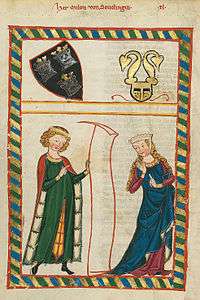Meinloh von Sevelingen
Meinloh von Sevelingen was a 12th Century Minnesänger from Swabia and one of the earliest poets in the tradition.

Life
There is no documentary record of Meinloh's life. Sevelingen is modern Söflingen, now a part of the city of Ulm. Around 1240 a "Meinlohus de Sevelingen" is documented as the seneschal of Count Hartmann von Dillingen,[1] but this is too late to be identified with the poet, who works are dated in stylistic grounds to 1160–1170. In all probability the poet was an ancestor of this documented namesake.[2]
Works
Manuscripts
Meinloh's work is preserved in the two main Minnesang collections:[3]
- The Weingarten Manuscript (B), early 14th Century, contains 11 strophes under Meinloh's name.
- The Codex Manesse (C), c. 1310, contains 14 strophes under Meinloh's name, including all those in B.
Both codices have a miniature.
The final two strophes in C are generally ascribed not to Meinloh but to Reinmar von Hagenau, since the first of them (Swem von guoten wîben liep geschiht) is duplicated later in the manuscript (folio 107r) under Reinmar's name.[4]
Two of the strophes in B and C have been regarded as "inauthentic", that is, not written by Meinloh.[5]
Form
The form of Meinloh's lyrics is characteristic of the early Danubian Minnesang: single-strophe works based on the "Langzeile" associated with the Nibelungenlied (a long line broken by a caesura) and rhyming couplets with impure rhymes permitted.[6][7]
However, he is also the first Minnesänger to show influence from the Rhineland and thus from the troubadours and trouvères.[6] This is apparent in the tri-partite structure of most of his strophes, which have the seven-line rhyme-scheme aa|bb|cxc, an anticipation of the later classic canzona form ab|ab|cxc. The unrhymed sixth line (the "Waise" or "orphan") is a characteristic Romance import.[8]
Commemoration
Present-day Söflingen has a Meinloh-Straße, and Meinloh is commemorated as one of the four local "sons of the muses" on the public fountain in the centre of Söflingen.[9] The local primary school is called the Meinloh-Grundchule, and the nearby Söflinger Meinloh-Forum is an open-air performance and event venue.
Example text
MHG text [10]
Ich sach boten des sumeres, daz wâren bluomen alsô rôt.
weistu, schoene vrowe, waz dir ein ritter enbôt?
verholne sînen dienest; im wart liebers nie niet.
im trûret sîn herze, sît er nu jungest von dir schiet.
Nu hoehe im sîn gemüete gegen dirre sumerzît.
frô wirt er niemer,
ê er an dînem arme sô rehte güetliche gelît.
Translation
I saw the heralds of summer they were flowers so red.
Do you know, fair lady, what a knight has offered you?
His service in secret; nothing means more to him.
His heart is sorrowful since last he parted from you.
Now raise his spirits for this summertime.
He will never be happy
Until he lies in your arms so contentedly.
See also
Notes
- Burdach 1892.
- Händl 1990.
- Handschriftencensus.
- Moser & Tervooren, p. 380.
- Moser & Tervooren, p. 31.
- de Boor 1972, p. 242.
- Schweikle 1989, p. 82.
- Paul & Glier 1979, pp. 87, 89.
- Schempp 2013, pp. 12–13.
- Moser & Tervooren 1988, p. 30.
Editions
- Lachmann, Karl; Haupt, Moritz; Vogt, Friedrich, eds. (1888). "III: Her Meinloh von Sevelingen". Des Minnesangs Frühling (4 ed.). Leipzig: Hirzel. pp. 11–15. Retrieved 11 July 2017.
- Bartsch, Karl; Golther, Wolfgang, eds. (1893). "IV: Hêr Meinlôh von Sevelingen". Deutsche Liederdichter des 12. bis 14. Jahrhunderts (4 ed.). Stuttgart: G.J. Göschen. pp. 10–11. Retrieved 11 July 2017.
- Moser, Hugo; Tervooren, Helmut, eds. (1988). "III: Meinloh von Sevelingen". Des Minnesangs Frühling. I: Texts (38 ed.). Stuttgart: Hirzel. pp. 28–31. ISBN 3777604488.CS1 maint: ref=harv (link)
Sources
- Burdach, Konrad (1892). "Sevelingen, Meinloh von". Allgemeine Deutsche Biographie (in German). 34. Berlin: Duncker & Humblot. pp. 72–73.CS1 maint: ref=harv (link)
- de Boor, Helmut (1974). Geschichte der deutschen Literatur. II, Die höfische Literatur. Vorbereitung, Blüte, Ausklang (9th ed.). Munich: C.H.Beck. ISBN 3406007090.CS1 maint: ref=harv (link)
- Händl, Claudia (1990). "Meinloh von Sevelingen". Neue Deutsche Biographie (in German). 16. Berlin: Duncker & Humblot.CS1 maint: ref=harv (link)
- Handschriftencensus. "Gesamtverzeichnis Autoren/Werke Meinloh von Sevelingen". Handschriftencensus. Retrieved 11 July 2017.CS1 maint: ref=harv (link)
- Paul, Otto; Glier, Ingeborg (1979). Deutsche Metrik (9th ed.). Munich: Max Hueber. ISBN 3190017190.CS1 maint: ref=harv (link)
- Schempp, Otto (2013). "Der Brunnen auf dem Söflinger Gemeindeplatz" (PDF). Söflinger Anzeiger. No. 02/13. Ulm (published June 2013). Retrieved 11 July 2017.CS1 maint: ref=harv (link)
- Schweikle G (1985). "Meinloh von Sevelingen". In Ruh K, Keil G, Schröder W (eds.). Die deutsche Literatur des Mittelalters. Verfasserlexikon. 6. Berlin, New York: Walter De Gruyter. pp. 314–318. ISBN 978-3-11-022248-7.CS1 maint: ref=harv (link)
Further reading
- Sayce, Olive (1982). The Medieval German Lyric 1150-1300. Oxford: Clarendon. pp. 94–96. ISBN 0-19-815772-X.CS1 maint: ref=harv (link)